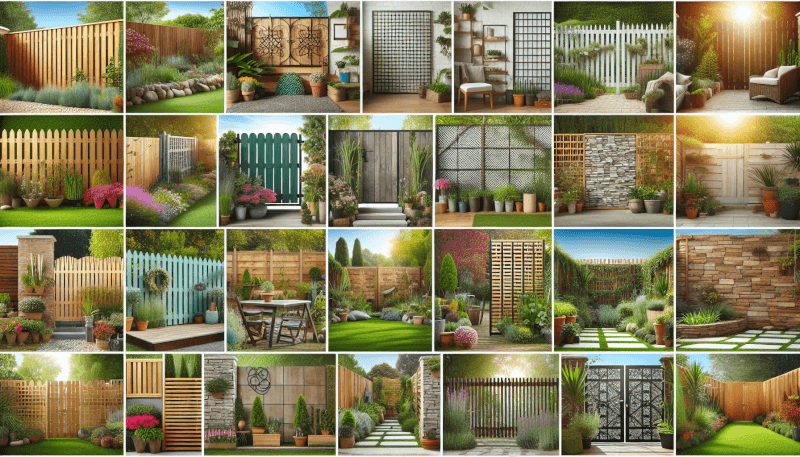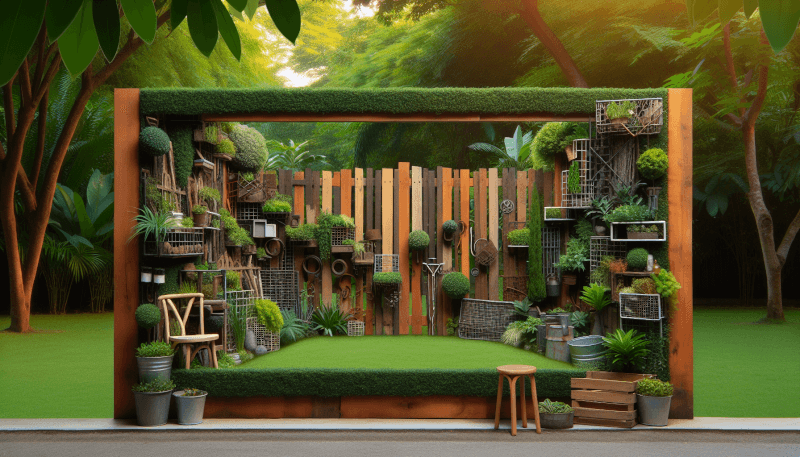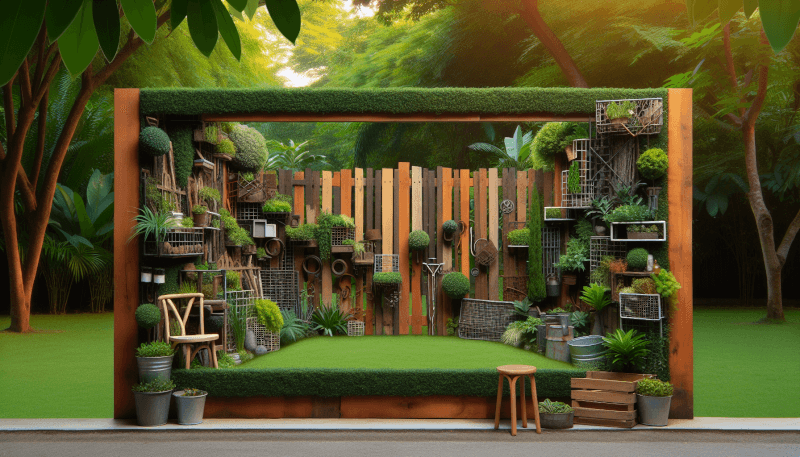Whether you’re looking to keep out unwanted critters or create a safe space for your furry friends to roam freely, a garden fence is an essential addition to any outdoor space. In this article, we’ll explore a variety of DIY garden fence ideas that not only provide security but also add a touch of charm and style to your yard. From classic wooden fences to creative alternatives like pallet fences and living walls, you’ll find inspiration for creating a secure and beautiful outdoor oasis that suits your needs and personal taste. When it comes to creating a secure outdoor space, one of the most important elements to consider is the garden fence. A well-designed and sturdy fence not only offers privacy and security but also adds beauty and style to your garden. With numerous types of garden fences available, it can be overwhelming to choose the right one for your needs. In this article, we will explore different types of garden fences, considerations before building a fence, and various DIY ideas for privacy, security, decoration, and sustainability. So let’s dive in and discover the perfect garden fence for you!

1. Types of Garden Fences
Chain Link Fences
Chain link fences, often made from galvanized steel, are one of the most popular options for homeowners due to their affordability and durability. These fences provide security while allowing visibility, making them ideal for keeping pets or children safe within the yard. Additionally, chain link fences require minimal maintenance, making them a practical choice for busy individuals.
Wooden Fences
Wooden fences create a timeless and classic look for any garden. They offer privacy and can be customized to various heights, styles, and finishes to match your aesthetic preferences. Whether you choose traditional picket fences or modern horizontal designs, wooden fences can enhance the overall appeal of your outdoor space while providing a sense of security.
Vinyl Fences
Vinyl fences are a low-maintenance alternative to traditional wooden fences. They are resistant to rot, pests, and weather conditions, making them durable and long-lasting. Vinyl fences come in various colors and styles, including privacy panels and decorative lattice tops, allowing you to create a beautiful and secure garden space without the hassle of regular maintenance.
Bamboo Fences
For those seeking a natural and eco-friendly option, bamboo fences are an excellent choice. Not only are they aesthetically pleasing, but they are also sustainable and durable. Bamboo fences provide privacy while allowing airflow, making them ideal for creating a tranquil and secluded garden environment. Moreover, bamboo is known for its fast growth, making it a renewable resource.
Wrought Iron Fences
If you’re looking for a combination of elegance and security, wrought iron fences are a perfect match. These fences are known for their ornate designs and intricate craftsmanship, adding a touch of sophistication to any garden. Wrought iron fences are strong and durable, providing excellent security while still maintaining visibility and openness.
2. Considerations Before Building a Garden Fence
Purpose of the Fence
Before choosing a garden fence, it’s essential to determine its primary purpose. Are you primarily looking for privacy, security, or decoration? Understanding your needs will help you select the right type and style of fence that best suits your requirements.
Local Building Codes and Regulations
Check your local building codes and regulations before building a garden fence to ensure compliance. Different areas may have specific requirements regarding fence height, setback distances, materials, and even style restrictions. By adhering to these guidelines, you can avoid potential legal issues and ensure a hassle-free installation process.
Budget and Cost
Setting a budget for your garden fence project is crucial. Consider the cost of materials, tools, and labor if you plan to hire professionals. Remember that different fence materials may vary significantly in price, so it’s essential to choose a fence type that aligns with your budget without compromising on quality and security.
Maintenance Requirements
Different fence materials have varying maintenance requirements. Some may require regular staining, painting, or sealing, while others may be virtually maintenance-free. Consider your willingness and ability to maintain the fence over time when selecting the right material. This will help you choose a fence that suits your lifestyle and saves you time and effort in the long run.
Aesthetics and Design
A garden fence is not only functional but also contributes to the overall beauty and ambiance of your outdoor space. Consider the architectural style of your home and the existing landscape when choosing the design and color of your fence. Finding a fence that complements your surroundings will enhance the visual appeal of your garden and create a cohesive and inviting atmosphere.

3. Privacy Garden Fence Ideas
Tall Wooden Fence Panels
When privacy is a top priority, tall wooden fence panels are an excellent choice. These panels provide a barrier that prevents prying eyes from seeing into your garden, creating a secluded and intimate space for you to enjoy. You can opt for traditional vertical slat designs or experiment with horizontal or diagonal patterns to add a modern touch.
Hedge Fences
For a natural and green alternative, consider using hedge fences to create privacy in your garden. Planting tall and dense shrubs or bushes along the perimeter of your yard can offer both seclusion and beauty. Popular hedge plant options include arborvitae, leyland cypress, and privet. Keep in mind that maintaining a hedge fence requires regular trimming and pruning to ensure it remains dense and visually appealing.
Picket Fences with Privacy Slats
If you prefer a more subtle approach to privacy, consider combining picket fences with privacy slats. Picket fences offer a charming and classic look, while privacy slats allow you to create a more enclosed space. These slats can be inserted between the pickets, adding a modern twist to the traditional picket fence design while providing the desired privacy.
Vertical Garden Fence
Why limit yourself to just a fence when you can also create a vertical garden? A vertical garden fence combines functionality and aesthetics by allowing you to grow plants vertically on the fence surface. Using hanging planters, trellises, or an innovative modular system, you can transform your garden fence into a lush and vibrant living wall that provides both privacy and a stunning visual display.
Living Wall Fences
For a truly unique and eco-friendly privacy solution, consider living wall fences. Living walls consist of carefully selected plants grown in vertical containers attached to the fence panels. These green walls not only provide privacy but also contribute to air purification, sound insulation, and a sense of tranquility. With a wide variety of plants to choose from, you can create a customized and sustainable living wall that suits your garden’s style and climate.
4. Security Garden Fence Ideas
Electric Fences
When it comes to maximizing security, electric fences are highly effective deterrents. These fences, equipped with an electric charge, can deliver a harmless but surprising shock to anyone who touches them. Electric fences are commonly used to secure livestock enclosures, but they can also be utilized for additional security around your garden. However, it’s crucial to ensure that electric fences comply with local regulations and are appropriately installed to ensure the safety of both humans and animals.
Cactus Fences
For a natural and formidable security barrier, cactus fences are an unconventional yet effective option. Cacti not only provide an impenetrable wall of spines but also add a unique aesthetic to your garden. Choose from a variety of cactus species, such as the imposing saguaro or the prickly pear, to create a living security fence that requires little maintenance but offers high security.
Razor Wire Fences
Razor wire fences are commonly used for high-security areas, such as prisons and military installations. These fences consist of intertwined metal strips with sharp edges, acting as an effective deterrent and preventing unauthorized access. While razor wire fences may not be suitable for every garden, they can be a viable option in certain situations where maximum security is required.
Steel Mesh Fences
Steel mesh fences, also known as chain link fences, can be upgraded to enhance security by adding a layer of steel mesh or wire on top of the standard chain link. This added mesh layer increases the height and strength of the fence, making it harder to climb or breach. Steel mesh fences provide both visibility and security, making them suitable for residential properties that require a balance between protection and aesthetics.
Double-layered Fences
For ultimate security, consider installing a double-layered fence system. This involves building two fences with a gap between them, creating a buffer zone that prevents intruders from easily accessing your property. The inner fence can be made of a solid material like concrete or brick, while the outer fence can be a more decorative option, such as an ornamental metal fence. This double-layered approach offers a strong deterrent and provides an extra layer of protection for your garden.

5. Decorative Garden Fence Ideas
Painted Wooden Fences
Add a splash of color and personality to your garden by painting your wooden fence. Whether you prefer a vibrant hue or a subtle pastel shade, painting your fence can transform it into a decorative and eye-catching feature. Consider matching the color of the fence to your garden’s color scheme or using contrasting colors to create a focal point. Remember to choose paint that is specially formulated for outdoor use to ensure durability and resistance to the elements.
Ornamental Metal Fences
Ornamental metal fences combine functionality and elegance to create a visually stunning garden boundary. From intricate ironwork to sleek and modern designs, ornamental metal fences can add a touch of sophistication to any outdoor space. These fences are available in various styles, including scrolls, finials, or geometric patterns, allowing you to choose a design that complements your garden’s aesthetic.
Stone or Brick Fences
For a timeless and traditional look, consider using stone or brick to construct your garden fence. Stone or brick fences provide a rustic and charming appeal while offering durability and strength. These fences can be built using natural stones or bricks and can be customized with decorative elements such as ornamental caps or pillars. A stone or brick fence creates a beautiful and enduring boundary for your garden.
Garden Trellis Fences
Garden trellis fences combine functionality with a touch of whimsy. These fences consist of a framework of lattice or interwoven panels, allowing climbing plants to grow and create a stunning visual display. Garden trellis fences provide a sense of enclosure while adding vertical interest and greenery to your garden. You can choose from a variety of materials, such as wood or metal, and experiment with different plant species to create a unique and enchanting fence design.
Artistic Mural Fences
Transform your garden fence into a work of art by commissioning an artistic mural. Talented artists can create custom murals on the surface of your fence, transforming it into a unique and eye-catching feature. Whether you prefer a nature-inspired scene, abstract artwork, or a depiction of your favorite animals, an artistic mural fence can enhance the overall aesthetic of your garden while showcasing your personal style and creativity.
6. DIY Garden Fence Installation
Determine the Fence Layout and Measurements
Before starting the installation process, it’s important to determine the fence layout and measure the area accurately. Mark the boundaries of your garden and plan the location of fence posts and panels accordingly. Taking accurate measurements will help you calculate the amount of materials needed for the project and ensure an efficient installation.
Purchase Materials and Tools
Once you have determined the fence layout and measurements, it’s time to purchase the necessary materials and tools. Depending on the type of fence you choose, you will need materials such as fence panels, fence posts, concrete, nails or screws, and any additional accessories required for installation. Make sure to purchase high-quality materials that are suitable for your specific project.
Prepare the Ground and Mark Fence Post Locations
Before installing the fence posts, it’s essential to prepare the ground properly. Remove any obstacles such as rocks, roots, or vegetation that could interfere with the installation process. Mark the locations of the fence posts using stakes or markings on the ground to ensure that they are evenly spaced and aligned.
Install Fence Posts
The next step in the installation process is to install the fence posts. Dig holes at the marked locations using a post hole digger or an auger. The depth of the holes will depend on the height of the fence and the type of soil in your garden. Once the holes are dug, insert the fence posts into the holes and fill them with concrete to secure the posts in place. Ensure that the posts are level and plumb before the concrete sets.
Attach Fence Panels or Materials
After the fence posts have been installed and the concrete has cured, it’s time to attach the fence panels or materials. Follow the manufacturer’s instructions for your specific fence type to ensure proper installation. Whether you are using pre-assembled panels or individual materials, make sure they are secured firmly to the fence posts using nails, screws, or appropriate fasteners.
Add Finishing Touches
To complete the DIY garden fence installation, add the necessary finishing touches. This may include adding decorative caps or post finials, staining or painting the fence for protection and aesthetics, and trimming any excess material for a clean and polished look. Take your time to inspect the final result, making any necessary adjustments or repairs before enjoying your newly installed garden fence.

7. Maintaining and Repairing a Garden Fence
Regular Cleaning and Inspection
Proper maintenance of your garden fence is essential to prolong its lifespan and keep it looking its best. Regularly clean your fence by removing dirt, debris, and any organic matter that may accumulate over time. Inspect the fence for signs of damage, such as loose or damaged panels, rotting wood, or rusted metal. Addressing these issues promptly will prevent further damage and ensure the security and integrity of your fence.
Repairing Damaged or Loose Fence Panels
Over time, fence panels may become loose or damaged due to weather conditions, impact, or wear and tear. Repairing these issues promptly is crucial to maintain the security and appearance of your garden fence. Depending on the type of fence, you may need to reattach or replace individual panels, reinforce weak sections, or repair any structural damage. Follow the manufacturer’s instructions or consult a professional if you are unsure how to proceed with the repairs.
Staining or Painting Wooden Fences
If you have a wooden fence, regular staining or painting is necessary to protect the wood from moisture, UV rays, and other environmental factors. Staining or painting your fence not only enhances its appearance but also helps to prevent rot and decay. Before applying any stain or paint, ensure that the fence is clean and dry. Follow the manufacturer’s instructions for your chosen product, and consider applying multiple coats for optimal protection and longevity.
Replacing Broken or Rusted Hardware
The hardware, such as hinges, latches, or fasteners, on your garden fence may deteriorate over time due to exposure to the elements. Replacing broken or rusted hardware is crucial for the proper functioning and security of your fence. Choose high-quality, weather-resistant hardware that is suitable for your specific fence type. Regularly inspect and lubricate the hardware to prevent rust and ensure smooth operation.
Trimming Plants and Vegetation around the Fence
Plants and vegetation growing around your garden fence can cause damage over time if left unchecked. Tree branches, vines, or other plants can grow into fence panels or cause them to warp or break. Regularly trim and maintain any plants or vegetation near your fence to prevent such issues. It’s important to strike a balance between a well-maintained garden and ensuring that plants do not pose a risk to the integrity of your fence.
8. Green and Sustainable Garden Fence Ideas
Recycled Materials Fence
For an eco-friendly approach, consider building a garden fence using recycled materials. Repurposing materials such as reclaimed wood, recycled plastic, or salvaged metal not only reduces waste but also adds unique character to your garden. Get creative and think outside the box when sourcing recycled materials, transforming them into a one-of-a-kind fence that showcases your commitment to sustainability.
Living Fence with Climbing Plants
Create a green and sustainable garden fence by incorporating climbing plants into your design. Climbing plants not only add a natural and vibrant element to your fence but also provide habitat and food for beneficial insects and birds. Choose fast-growing and low-maintenance climbers such as honeysuckle, clematis, or ivy to create a living fence that requires minimal care while providing environmental benefits.
Solar-Powered Lighting for the Fence
Illuminate your garden fence while reducing your carbon footprint by using solar-powered lighting. Solar-powered lights can be installed on or along the fence to provide ambient lighting and enhance the security of your outdoor space. These lights harness the power of the sun during the day and automatically turn on at dusk, providing an energy-efficient and cost-effective lighting solution for your garden.
Water Collection and Irrigation System
Maximize sustainability by integrating a water collection and irrigation system into your garden fence. This can be achieved by installing rain barrels or a water collection system along the fence to capture and store rainwater. The collected water can then be used to irrigate your garden, reducing the need for additional water sources. This sustainable approach conserves water and minimizes wastage, ensuring that your garden remains healthy and thriving.
Composting Fence
Transform your garden fence into a functional and sustainable feature by creating a composting system. Attach compost bins or containers to the fence to conveniently compost kitchen scraps and garden waste. These composting fences not only provide a space-saving solution for composting but also supply nutrient-rich compost for your garden. By recycling organic matter, you can reduce waste while promoting healthy soil and plant growth.

9. Practical Garden Fence Tips and Tricks
Digging Deep Fence Post Holes
To ensure a sturdy and secure garden fence, it’s important to dig deep fence post holes. Experts recommend digging holes that are at least one-third the height of the fence above ground. This provides a solid foundation for the fence posts, preventing them from shifting or leaning over time. Consider using a post hole digger or an auger to achieve the necessary depth efficiently.
Using Concrete Footings for Posts
Using concrete footings when installing fence posts is essential for added stability and long-term durability. Before pouring the concrete, tamp down a layer of gravel at the bottom of the post hole for drainage. Place the post in the hole and pour concrete around it, ensuring that it completely fills the hole. Use a level to ensure that the post is plumb and adjust as necessary before the concrete sets.
Installing a Gate for Easy Access
If you plan to have easy access to your garden, installing a gate is a practical and functional addition. Remember to determine the appropriate size and style of the gate to accommodate both people and any equipment or machinery that needs to enter the garden. Use sturdy hinges and latches to secure the gate and ensure smooth operation.
Adding Locks and Security Measures
For enhanced security, consider adding locks and other security measures to your garden gate. Choose locks that are specifically designed for outdoor use and can withstand various weather conditions. Additionally, consider incorporating motion-detection lights or a security camera system to monitor and deter potential intruders.
Using Weatherproof and Durable Materials
Choosing weatherproof and durable materials is essential for the long-term performance and lifespan of your garden fence. Ensure that the materials you select are specifically designed for outdoor use and can withstand the elements. Consider materials that are resistant to rot, pests, rust, or fading to ensure that your fence remains in top condition for years to come.
10. Ideas for Combining Different Fence Styles
Mixing Wood and Metal Fences
Create a unique and stylish garden fence by combining the warmth of wood with the modernity of metal. This combination can be achieved by using wood panels or posts and incorporating metal elements such as decorative inserts, trellises, or gates. This harmonious blend of materials adds visual interest and can complement various architectural styles.
Integrating Garden Art with Fencing
Incorporate art into your garden fence by integrating sculptures or other outdoor art pieces. Attach them to the fence panels or place them strategically around the boundary to create a stunning and artistic display. Choose pieces that reflect your personal taste and style while harmonizing with the overall aesthetic of your garden.
Combining Privacy and Decorative Fences
Achieve both privacy and visual appeal by combining privacy and decorative fencing elements. This can be done by incorporating decorative panels or lattice inserts into a traditional privacy fence design. These additions add a touch of elegance and sophistication to an otherwise simple and utilitarian fence.
Creating a Border with Multiple Fence Designs
Divide your garden into distinct areas by creating borders using different fence designs. This can be achieved by using various fence materials, heights, or colors to demarcate separate spaces within your garden. Whether you want to separate a dining area, create a designated play area for children, or establish a serene corner for relaxation, a combination of fence styles can help you achieve these goals.
Using Planters or Flower Beds as Fence Accents
Add charm and color to your garden fence by incorporating planters or flower beds along its length. Planters or flower beds attached to the fence can serve as both space-saving solutions for gardening and captivating accents for your fence. Choose a variety of plants, flowers, and vines to create a captivating and ever-changing display throughout the seasons.
With the plethora of garden fence options and ideas available, you can create a secure outdoor space that reflects your style and meets your needs. Whether you prioritize privacy, security, decoration, sustainability, or a combination of these aspects, there is a garden fence design for everyone. Consider the different types of garden fences, keep in mind the essential considerations before building a fence, and explore various DIY ideas to unleash your creativity and transform your garden into a safe and enchanting sanctuary. Remember to prioritize functionality and durability while adding your personal touch to create the perfect garden fence for years of enjoyment!


